Here are more post Pacific Crest Trail evaluations of my hiking gear: hiking water system including water purification, a water filter, and water storage.
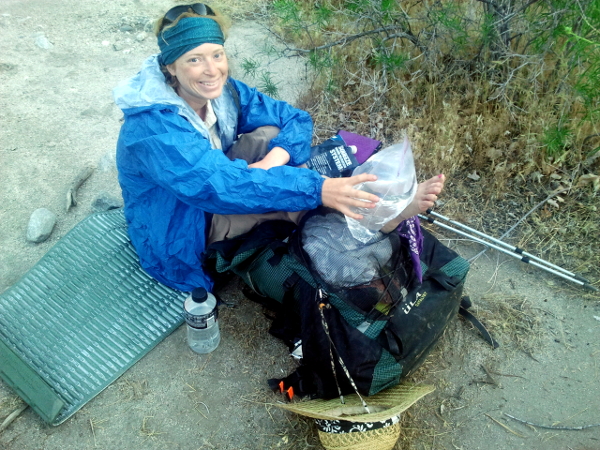
Hiking Water Purification
A Steripen was going to be my go to water purification on the trail. Mostly because I already owned one so didn’t have to shell out more money for water purification gear. I didn’t carry my for very long. It failed my gear simplicity rule – too many moving parts so to speak. Sometimes it would work and sometimes it wouldn’t. Lights would be blinking. We’d look up in the owner’s manual saved on the smartphone to figure out how to get it to work again. I also carried extra batteries for it. I ended up shipping it home since it was too expensive a piece of gear to just put in a hiker box).
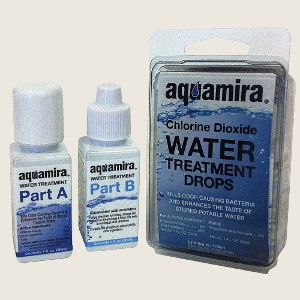
I carried Aquamira for my backup water treatment. Eventually it became my primary water treatment because it’s so easy to use. Seven drops of part A into the mixing cap. Then seven drops of part B. Wait for it to turn neon yellow. Put it in your water bottle and wait 15 minutes. Then drink. I don’t mind the taste. Kind of lemony to me. And when I got tired of the taste, I would just add Emergen-C, instant iced tea, or lemonade mix to the water. One problem – sometimes the Aquamira containers would crack and leak. Not cool. I carried it in a pocket on my hip belt. I think the leaking Aquamira was responsible for eating a hole in the hip belt pocket that got larger and larger. Sometimes I wondered whether the chemicals in Aquamira were very good for my body. I should probably use a water filter more often.
Hiking Water Filter
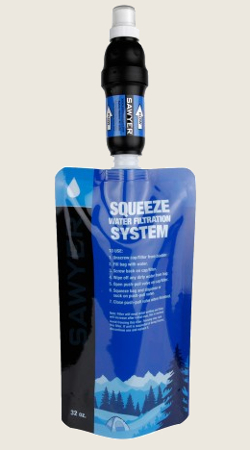
I read about the Sawyer Squeeze Water Filter on the PCT-L and followed a link to John Abela’s review at HikeLighter.Com shortly before my PCT hike. I bought one on a pro deal. Blaze carried it and used it as her primary water treatment. Dances With Lizards and I would use it sometimes but tended to use the Aquamira as our primary water treatment. We were a bit impatient waiting for a turn with the squeeze filter.
The Sawyer Squeeze Water Filter is simple to use, simple to maintain, and only weighs 3 oz. The syringe that comes with it for back-flow cleaning the filter doubles as a wound irrigator for first aid. I found the filter to take a long time to use. The best technique for squeezing for me was rolling the bag like a tube of toothpaste starting from the bottom (sorry for all you middle of the toothpaste tube squeezers). Sometimes Blaze would hold the squeeze bag between her knees while sitting and let gravity filter the water. Then her hands were free for eating or writing in her journal. But it looked and sounded like … well, you probably get the picture.
Another drawback to the Sawyer Squeeze Water Filter are that the bags are not durable. They would tend to break and leak around the threaded opening where the filter attached. I recommend having extra Sawyer Squeeze Bags in a bounce box. We learned the hard way. When our single, 2-Liter squeeze bag leaked, we patched it with Slime Skabs patches. Fortunately, we found extra Sawyer Squeeze Bags in a hiker box at the hardware store in Wrightwood. Looked like someone got a filter set with multiple bags or ordered extra bags that they didn’t want to carry. We replaced the broken bag and put an extra in our bounce box.
At nasty water sources, we would take the time to filter water for everyone and treat it with Aquamira. Like at the Red Rock Water Tank near trail mile 502. We were all out of water and it was desert hot. The tank had a foot of water or so in the bottom with dead birds floating in it. We quit looking, rigged up a cook pot on a rope to fetch the water out, filtered it, then blasted it with Aquamira.
Hiking Water Storage
Changing my water storage was one of my first steps in going to lightweight hiking gear. I used to carry 1-Liter Nalgene and stainless steel bottles. Not anymore.
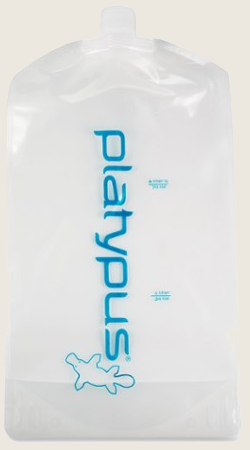
I carried 2-Liter Platypus Platy Bottle. So did Blaze and Dances With Lizads. I started out with a drink tube for mine, but I’m not a fan of these. I find it hard to drink water out of the tube while walking and not get short of breath (but I can chew gum and walk at the same time no problem). I also find it awkward to use the tube and keep it in place on the pack. The tube flaps around and gets in the way of my arm. I put mine in a hiker box. It was extra weight anyway. I find Platy Bottles to be pretty durable overall. Dances With Lizard’s leaked after 1500 miles but was easy to repair with Slime Skabs patches. Platy Bottles also double as a cold pack for sore ankles, calves, and knees. Mine would often stay cool in the pack, but was easy enough to cool down in a creek, flowing spring, or snow bank.
We managed to lose a Platy Bottle Closure Cap. So I bought extras at an outdoor gear shop in Idyllwild. One to go on the bottle, one in the repair kit, and one in the bounce box.
I started out with two re-used Powerade bottles for my water bottles. When these were no longer useable, I switched over to Glaceau smartwater brand bottles. These are tall, thin 1-Liter containers. I preferred these over the short and squat Gatorade or Powerade type bottles. The tall, thin bottles fit my hand better, fit nicely in the side pockets of my ULA Catalyst pack, and were easy to reach with the the pack on. Occasionally, I would find various generic, tall and thin store brand water bottles, but these never seemed to be as durable as the Glaceau Smartwater brand.
I also carried a 12-ounce Gatorade type bottle just for flavored beverages and hot drinks. This kept my other bottles free of mildew so I didn’t have to replace them for a long time. When the flavored beverage bottle got nasty, I got another one at a stop in a trail town (and recycled the old one).
For My Next Hike
Silent D carried a gravity water filter. I recently looked at these thinking about what I might carry on my next hike. Just fill them up, hang them, and let gravity do the rest while you go on with eating, camp chores, hanging out, or whatever. The simplest systems are the Sawyer Water Filter System and Katadyn Base Camp Water Filter. Both weigh 11 oz. Probably too heavy to carry in my kit. I’ll probably stick with the Sawyer Squeeze Water Filter and figure out how to gravity filter with it.



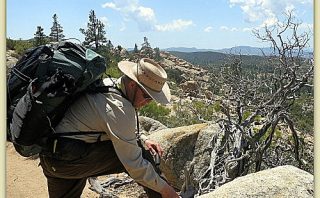
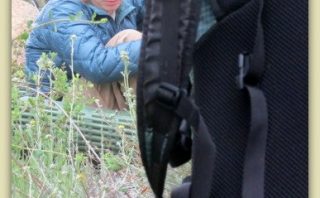
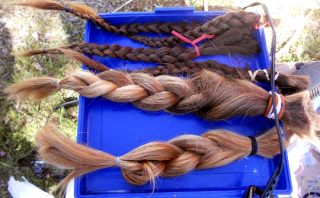

Hey Guys!
Totally agree that the Sawyer bags are seriously not durable enough. I am so sorry I did not get this discovered in time for your PCT thru-hike!
You should try to acquire some of the Evernew Water bags for your next hike. They are significantly more durable (though a few folks on the PCT did have them fail while using a Squeeze, but guess is they were squeezing the crap out of the bags – rather than rolling the bags – which would cause just about any of the water bags to pop). You can read up on these bags a bit more in this brief article I wrote concerning these bags and the Sawyer Squeeze.
Also, Chad “Stick” came up with a way to turn the Squeeze into a gravity system. The Sawyer bags have just enough room on the bottom to use a hole punch on each side, than just throw some line through it and good to go.
My Squeeze takes around 70 seconds to do a two liter bag. That tends to be fast enough for me. But that leads up to a question I had. I have been reading a lot of other post-hike-thoughts on the Squeeze and a number of folks have been saying that they were having to backflush way more often then what they were expecting. How often did you guys find you had to backflush your squeeze in order to keep it flowing at a decent rate??
Also, thanks for the mention!!
You’re welcome for the mention. Lot’s of good info in your articles.
Regarding durability. Blaze went through two bags in the 1,144 miles she was on the trail. She left the trail near Donner Pass with injured ankles after walking with one or the other or both hurting for about 1,000 miles. I don’t know if that’s good or bad for a Mylar bag in a 3 oz water system. Most of us go through at least two pairs of shoes in that many miles.
I’ll take a look at the Evernew Water bags.
I’ll have to give Stick’s gravity feed method a try. Nice, simple solution.
I believe Blaze only back-flushed the filter every seven days or so when we stopped in a trail town. We went 14 days in the Sierra before getting to a town and I don’t recall her back-flushing the filter then. But, up there, we didn’t run every source of water through a filter or otherwise treat it so maybe the filter wasn’t getting regular use.